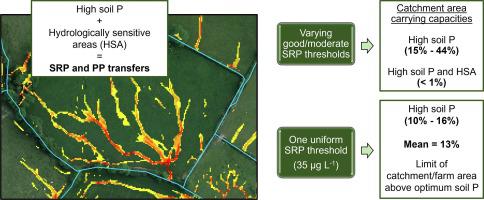Our official English website, www.x-mol.net, welcomes your feedback! (Note: you will need to create a separate account there.)
Soil phosphorus, hydrological risk and water quality carrying capacities in agricultural catchments
Catena ( IF 6.2 ) Pub Date : 2024-03-15 , DOI: 10.1016/j.catena.2024.107964 Alison Scott , Rachel Cassidy , Joerg Arnscheidt , Phil Jordan
Catena ( IF 6.2 ) Pub Date : 2024-03-15 , DOI: 10.1016/j.catena.2024.107964 Alison Scott , Rachel Cassidy , Joerg Arnscheidt , Phil Jordan

|
To support profitable agricultural production, nutrients, including phosphorus (P) are applied to soils. However, to avoid over-application and mobilisation of excess P, in-soil concentrations must be maintained at the agronomic optimum (crop requirement) through soil test P (STP) data. Areas above optimum STP (e.g., Olsen P) status have been linked to elevated instream soluble reactive P (SRP) concentrations. For example, when this status is combined with hydrologically sensitive areas (HSAs), excess P can be mobilised and transported directly to surface waters. Catchment carrying capacities for high STP are a possible management strategy to reduce these pressures. The aim of this study was to investigate the transferability of catchment carrying capacity approaches using primary and secondary datasets. Field by field STP status and LiDAR derived HSAs (2 m grid resolution) were compared with instream SRP concentrations using combinations of least squares regressions. The high range of STP catchment carrying capacities (15 % − 44 %, depending on the regression used) was influenced by the variation of instream SRP concentration thresholds (48 – 71 µg L) that are determined using altitude and alkalinity factors. However, a single SRP threshold of 35 µg L reduced the catchment STP carrying capacity to a smaller range (10 % − 16 %), with a mean of 13 %. The analysis showed that instream particulate P concentrations were also related to above optimum STP but to a lesser degree and that all HSAs were vulnerable to P loss when soils were above optimum STP. Targeted management strategies should follow a “treatment-train” approach starting with reducing the catchment or farm area above agronomic optimum STP to a carrying capacity (proposed here as 13 %), followed by interception measures located at HSA breakthrough and delivery points to reduce both instream SRP concentration and load.
中文翻译:

农业流域土壤磷、水文风险和水质承载能力
为了支持有利可图的农业生产,将包括磷 (P) 在内的养分施用于土壤。然而,为了避免过度施用和动员过量的磷,必须通过土壤测试磷 (STP) 数据将土壤浓度维持在农艺最佳值(作物需求)。高于最佳 STP(例如 Olsen P)状态的区域与河内可溶性反应性 P (SRP) 浓度升高有关。例如,当这种状态与水文敏感区(HSA)相结合时,过量的磷可以被动员并直接输送到地表水。高 STP 的流域承载能力是减轻这些压力的一种可能的管理策略。本研究的目的是利用主要和次要数据集研究流域承载能力方法的可转移性。使用最小二乘回归组合,将逐场 STP 状态和 LiDAR 衍生的 HSA(2 m 网格分辨率)与河内 SRP 浓度进行比较。 STP 流域承载能力的高范围(15% - 44%,取决于所使用的回归)受到使用海拔和碱度因素确定的河内 SRP 浓度阈值(48 - 71 µg L)变化的影响。然而,35 µg L-1 的单一 SRP 阈值将流域 STP 承载能力降低至较小范围 (10% – 16%),平均值为 13%。分析表明,河流内颗粒 P 浓度也与高于最佳 STP 相关,但程度较小,并且当土壤高于最佳 STP 时,所有 HSA 都容易受到磷损失的影响。有针对性的管理策略应遵循“处理系列”方法,首先将高于农艺最佳 STP 的集水区或农场面积减少到承载能力(此处建议为 13%),然后在 HSA 突破点和交付点采取拦截措施,以减少河内 SRP 浓度和负荷。
更新日期:2024-03-15
中文翻译:

农业流域土壤磷、水文风险和水质承载能力
为了支持有利可图的农业生产,将包括磷 (P) 在内的养分施用于土壤。然而,为了避免过度施用和动员过量的磷,必须通过土壤测试磷 (STP) 数据将土壤浓度维持在农艺最佳值(作物需求)。高于最佳 STP(例如 Olsen P)状态的区域与河内可溶性反应性 P (SRP) 浓度升高有关。例如,当这种状态与水文敏感区(HSA)相结合时,过量的磷可以被动员并直接输送到地表水。高 STP 的流域承载能力是减轻这些压力的一种可能的管理策略。本研究的目的是利用主要和次要数据集研究流域承载能力方法的可转移性。使用最小二乘回归组合,将逐场 STP 状态和 LiDAR 衍生的 HSA(2 m 网格分辨率)与河内 SRP 浓度进行比较。 STP 流域承载能力的高范围(15% - 44%,取决于所使用的回归)受到使用海拔和碱度因素确定的河内 SRP 浓度阈值(48 - 71 µg L)变化的影响。然而,35 µg L-1 的单一 SRP 阈值将流域 STP 承载能力降低至较小范围 (10% – 16%),平均值为 13%。分析表明,河流内颗粒 P 浓度也与高于最佳 STP 相关,但程度较小,并且当土壤高于最佳 STP 时,所有 HSA 都容易受到磷损失的影响。有针对性的管理策略应遵循“处理系列”方法,首先将高于农艺最佳 STP 的集水区或农场面积减少到承载能力(此处建议为 13%),然后在 HSA 突破点和交付点采取拦截措施,以减少河内 SRP 浓度和负荷。



























 京公网安备 11010802027423号
京公网安备 11010802027423号